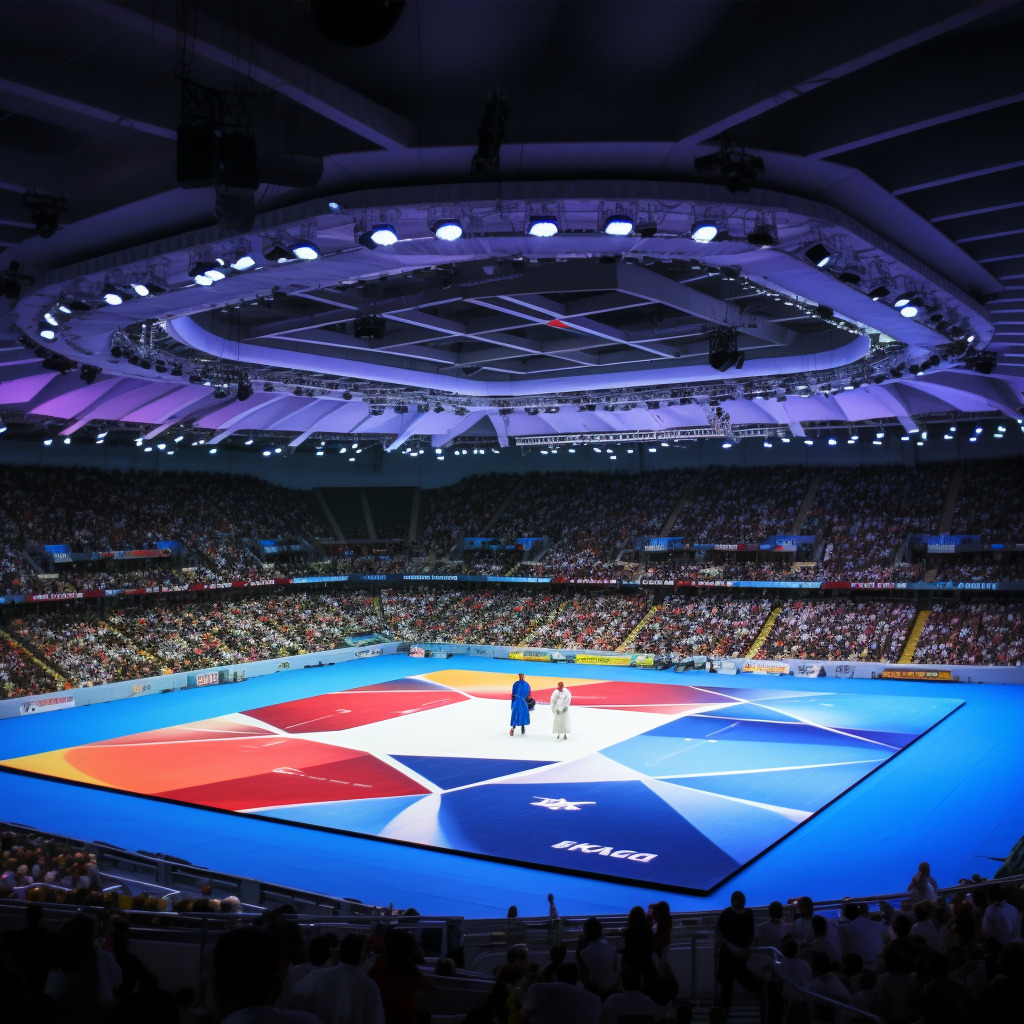Wie bei allen Sportarten gibt es auch beim Judo eine Rangliste, national, wie auch international. So werden im Rahmen von Wettbewerben und Sportveranstaltungen, die besten Judoka ermittelt. Wir geben einen kurzen Überblick und stellen die bekanntesten Wettkämpfe der Sportart vor.

Große Judo Turniere und Meisterschaften
Beim Judo stellen vor allem die Olympiade sowie Welt- und Europameisterschaften die wichtigsten Turniere dar. Im Folgenden möchten wir euch ein paar Hintergrundinformationen dazu erläutern.
Judo Olympiade
Die größte internationale Aufmerksamkeit bekommt Judo seit 1964 als Disziplin bei den olympischen Spielen, welche in einem Abstand von 4 Jahren ausgetragen werden.
- Aufgrund des großen öffentlichen Interesses an den olympischen Spielen findet die olympische Goldmedaille die größte Anerkennung.
- Im Video ist der 100kg Contest zwischen Teddy Riner und Hisayoshi Harasawa für die Goldmedaille 2016 in Rio.
- Weitere Videos von vergangenen Olypiaden gibt es auch auf Youtube
- Weitere Infos zur deutschen Judo Olympia Mannschaft gibt es hier
Judo Europa & Weltmeisterschaft
Die Judo Weltmeister werden in einem Abstand von 2 Jahren bei den Judo Weltmeisterschaften ermittelt, die seit 1956 regelmäßig stattfinden. In den Jahren 1980 bis 1986 fanden die Meisterschaften der Männer und Frauen getrennt und jeweils um ein Jahr versetzt statt, seit 1987 legte man die beiden Meisterschaften zusammen.
Die Europameisterschaften existieren seit 1951 und finden jährlich statt und werden von der europäischen Judounion organisiert. Auch hier wurde 1975 bis 1986 zwischen Männern und Frauen getrennt.
- Der Organisator ist die IJF (International Judo Federation).
- Im Video ist der Kampf zwischen Teddy Riner (FRA) und Sung-Min Kim (KOR) 2013 in Paris zu sehen.
- Die Liste der Gewinner findet ihr beim Judobund
Deutsche Judo Bundesliga
Die deutschen Mannschaftsmeister werden jährlich in der Judo Bundesliga ermittelt, die aus insgesamt 64 Mannschaften besteht und vom deutschen Judo-Bund ausgerichtet wird. Es gibt eine erste und eine zweite Bundesliga sowie verschiedene Regionalligen. Nur Vereine der 1. Bundesliga können deutscher Mannschaftsmeister werden. Diese ist in Nord und Süd aufgeteilt und funktioniert, ähnlich wie die Fußball-Bundesliga, mit einem System, welches Hin- und Rückrunden vorsieht.
Ermittelt wird der Meister dann letztlich in einer Finalrunde, welche Halbfinale und Finale umfasst. Der Letztplatzierte steigt, nach einem erfolglosen Relegationsspiel, in die 2. Judo Bundesliga ab.
Alle Meisterschaften haben gemeinsam, dass nach Gewichtsklassen unterschieden wird und meist auch separate Klassen für Altersgruppen gebildet werden (U15, U18, U21, Ü30). Die Ausnahme bildet die Judo Bundesliga, in der nur Gewichtsklassen existieren.
Aktuelle Stände der 1. und 2. Bundesliga für Männer und Frauen finder ihr auf www.deutsche-judo-bundesliga.de
Einteilung in Wettkampfklassen
Bei den Judo Gewichtsklassen im Wettkampf wird als erstes zwischen Männern und Frauen unterschieden. Ein generelles Mindestalter von 8 Jahren gilt für alle Teilnehmer und in allen Klassen.
- Für Männer und Frauen gibt es jeweils die Altersgruppen U12, U15, U18 und U21. Eine Teilnahme in der Erwachsenengruppe ist ab dem 17. Lebensjahr möglich.
- Die Einteilung in Gewichtsklassen erfolgt dann, abhängig von der Altersklasse, in Schritten von nur wenigen Kilos, um einen allzu großen Nachteil durch Gewichtsunterschiede auszuschließen. Für die Teilnahme an Mannschaftswettkämpfen gelten bei U15 und U18 außerdem noch Mindestgewichte, die keiner der Teilnehmer unterschreiten darf.
- Eine jährlich aktuelle Tabelle über die Judo Gewichtsklassen liefert der DJB.
Regeln und Verhaltensgrundsätze beim Wettkampf
Ziel eines Judo Wettkampfs ist es, den Gegner durch das Sammeln von Punkten oder durch dessen Aufgabe zu besiegen. Punkte erlangt Ihr durch das Festhalten des Gegners in Rückenlage auf dem Boden, wofür Euch diverse Techniken zur Verfügung stehen. Gekämpft wird auf einer quadratischen Matte, die von einem Sicherheitsbereich umgeben ist, der während des Kampfes nicht betreten werden darf. Er dient lediglich der Absicherung, falls einer der Kontrahenten aus dem Wettkampfbereich hinausfällt.
- Dass den Anweisungen des Kampfrichters mit sofortiger Wirkung zu folgen ist, sollte Euch ohnehin klar sein.
- An oberster Stelle steht der respektvolle Umgang miteinander. Das Begrüßen vor dem Kampf sowie das Abgrüßen nach dem Kampf ist zwar eine nette und symbolische Geste, den eigentlichen Respekt zollt Ihr Eurem Gegner aber dadurch, dass Ihr während des Kampfes fair bleibt.
- Der Grundsatz des respektvollen Umgangs miteinander zieht sich jederzeit durch das Leben des Judoka hindurch. Bereits im Dojo werdet Ihr erkennen, dass ein Verstoß gegen allgemeine Judo Regeln weder vom Trainer, noch von Mitschülern, geduldet wird. Im Wettkampf gilt dies in verschärfter Form, denn hier bekommt der Gegner für Regelverstöße Teilpunkte zugesprochen. Es ist also durchaus möglich, einen eigentlich sicheren Kampf allein durch Regelverstöße zu verlieren.
- Euer Verhalten sollte natürlich nicht nur auf der Matte, sonder auch abseits davon angemessen bleiben. Einen Gegner zu verhöhnen, sobald dieser die Matte verlassen hat, wird Euch mit ziemlicher Sicherheit größere Schwierigkeiten einbringen, als ein paar böser Blicke.
Was ist im Wettkampf erlaubt und was nicht?
Einige Techniken werden zwar im Judotraining oder der Kata gelehrt, dürfen aber im Wettkampf nicht eingesetzt werden. Hierzu zählen alle Formen der Schlagtechniken, egal ob mit Hand oder Fuß, sowie Würgetechniken, die Druck auf den Kehlkopf ausüben. Würgeangriffe gegen die Halsseite oder die Schlagadern hingegen sind erlaubt.
- Der Einsatz des Gürtels zum Fixieren oder Würgen ist in jeder Hinsicht verboten.
- Hebeltechniken sind nur gegen das Ellenbogengelenk erlaubt, alle anderen Gelenke sind ausgeschlossen.
- Ebenfalls untersagt sind Angriffe gegen einen Gegner, welcher die Wettkampffläche verlassen oder bereits aufgegeben hat.
- Boxsack Basics: Findet den perfekten Boxsack für euer Heimtraining - 23. November 2023
- Mobbing am Arbeitsplatz: Tipps & Hilfestellungen für Betroffene - 15. November 2023
- Wohnung & Haus effektiv vor Einbruch schützen: 10 Tipps & FAQ - 3. November 2023

